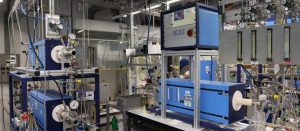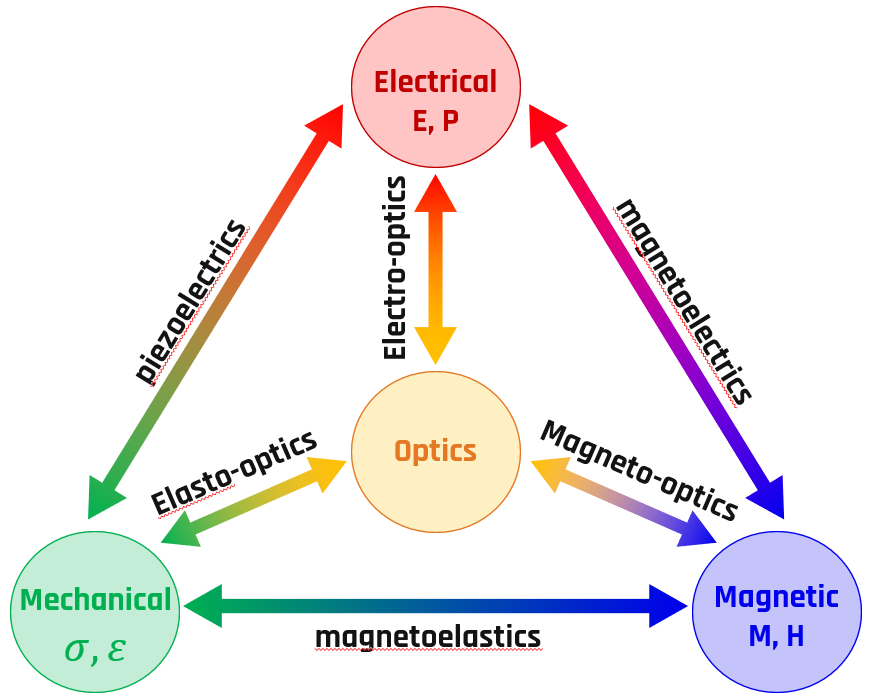Research at the MFM group
The MFM group is devoted to experimental investigations of crystalline matter by means of solid state spectroscopy methods, with a particular focus on new and original phase transitions, excitations, coupling phenomena, or active tuning of material properties.
Projects
Research highlights
Ferroic transitions constitute an immense field of studies. We describe here in more details some current research lines of interest in the MFM group.
Studies of model antiferroelectric crystals
Antiferroelectric crystals do not possess any dielectric polarisation, but they can undergo a transition to a new polar phase when subjected to a strong electric field. The concept is simple, but in reality, not so many antiferroelectric inorganic crystals are known, and those who are tend to be very complex.
In the MFM group, we investigate potential new antiferroelectric materials, if possible simple crystals that can serve as models for basic studies of their properties and lattice dynamics.
Some of our recent efforts have concentrated on a crystal called francisite. The chemistry of francisite is complex but its phase transition happens to be a one of a kind and a very simple case of one-dimensional transition. This exceptionally simple situation has allowed us to finally provide a full picture of the vibrational signature of an antiferroelectric transition in a real system.
We are also interested to push concepts for possible applications of antiferroelectric crystals. This has led us to dive into the details of a known antiferroelectric material (PbZrO3), and investigate its switching characteristics and the possibilities to modulate his optical properties as a function of an electric field.
Raman spectroscopy and resonant Raman scattering
Raman spectroscopy is one of the main expertise in the group. The principle of the measurement is inelastic scattering of light: a laser is sent onto to the sample of interest and the spectrum of the scattered light is analysed. In its most common use, it is used to measure the vibration frequencies of a crystal lattice. Since this frequency depends on the interatomic forces, it is typically very sensitive to any kind of change occuring in the crystal, like a change in crystal structure, in magnetic order etc.
As a recent example of a study carried out in the group, we used Raman spectroscopy to investigate the phase diagram of the solid solution between the antiferromagnetic 2D crystal MnPS3 and the paramagnetic ZnPS3. Changes in the Raman spectrum clearly reveal the magnetic phase diagram as the chemical composition varies between the two end-members.
Raman spectroscopy becomes more complex when the energy of the laser light becomes sufficient to excite electrons in the crystal. In that case, the intensity of the scattered light is greatly enhanced and does not only measure the energy of the lattice vibrations but also provides information on the electronic transitions. This principle is known in principle, and detailed interpretations have been worked out in other families of materials, but in our ferroic oxides where the chemistry and the electronic structures are complex, it is not trivial to extract and interpret this information. In the group, we try to make progress towards that goal.
Phase transitions induced by stress and strain
Applying pressure is a very efficient way to provoke and study structural phase transitions in crystals. Positive pressure brings the atoms closer together, thereby forcing them to reorganize and reveal details of their interactions that are otherwise difficult to observe. In other words, it is a way to stabilize exotic crystal structures that are not stable at ambient conditions. This also very often puts our theoretical understanding of these materials to the test.
A recent case study of an interesting high-pressure transition was the investigation of the controversies regarding the evolution of barium zirconate BaZrO3. This is a simple perovskite that is known for being cubic but very close to unstable, which makes its particularly sensitive. In a recent paper, we took advantage of the availability or recently synthesized single crystals to clarify its phase diagram.
In solids, negative hydrostatic pressure is more difficult to achieve experimentally. A good surrogate for negative pressure can be achieved by implanting helium: the chemically neutral helium atoms penetrate and inflate the crystal unit cells from within. The orders of magnitudes of the equivalent pressure are much lower than those achievable with positive pressure, but for those crystals with many competing structures, this can be sufficient to completely change their properties.

